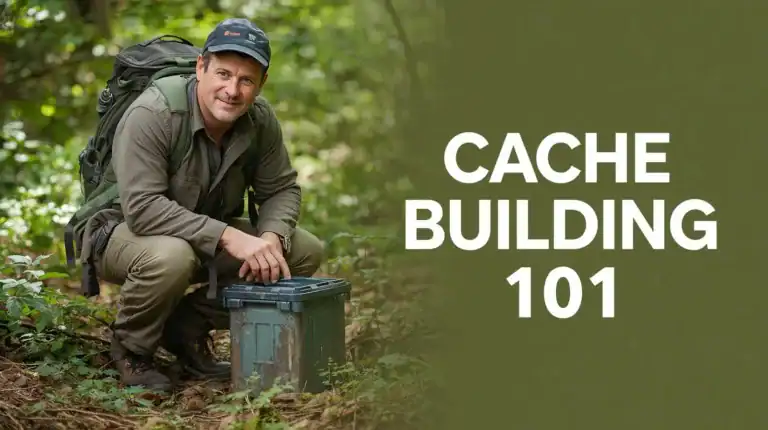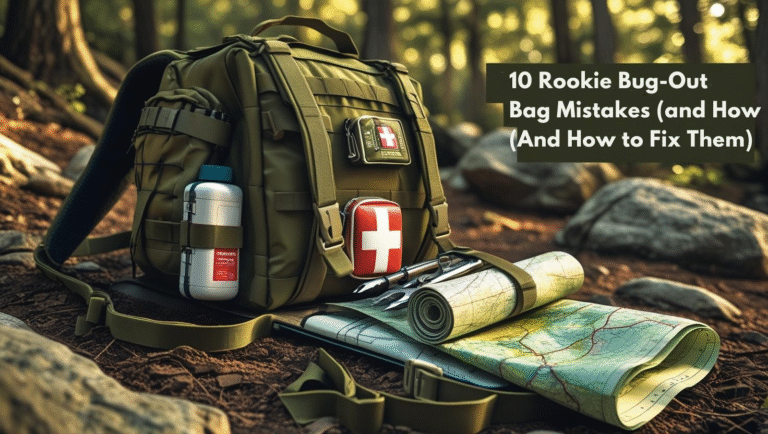
The Smart Prepper’s Pantry: How to Build a Food Stockpile Without Going Full Doomsday
When the grocery store shelves go bare, your stash should be full—and smarter than the average cereal hoarder.
Let’s face it: the world’s stability is about as reliable as a gas station sushi buffet. One cyberattack, freak storm, or supply chain meltdown—and suddenly people are fighting over the last can of SpaghettiOs like it’s the Hunger Games. If your food plan is “hope the fridge still works,” then we need to talk.
This post isn’t here to freak you out—it’s here to wise you up. Building a layered, low-drama food stockpile is one of the smartest things you can do to keep your household running when the rest of the world hits pause. Whether you’re prepping for a 3-day blackout or a long-term economic mess, we’ll show you how to feed yourself without resorting to squirrel stew or overpriced prepper kits that include a single Tic Tac and a spoon.
Welcome to the Grocery Store Apocalypse (…Or Just Tuesday)
Imagine walking into the store for bread and finding a shelf that looks like a scene from The Walking Dead. That’s not a horror movie—it’s a Tuesday in 2025. Supply chain drama, weather chaos, and political rollercoasters make food stockpiling not just smart… but necessary.
Let’s break it down like a calm, well-fed prepper.
The 3-Layer Food Stockpile System Every Smart Prepper Should Know
Building a food stockpile isn’t about throwing canned goods into a closet and calling it a day. A smart prepper thinks in layers—each with a clear purpose, duration, and style of storage. Here’s how to build a system that keeps you fed in a blackout, a bug-in, or a full-blown grid collapse.
🔹 Layer 1: 72-Hour Emergency Stash (The Bug-Out Box)
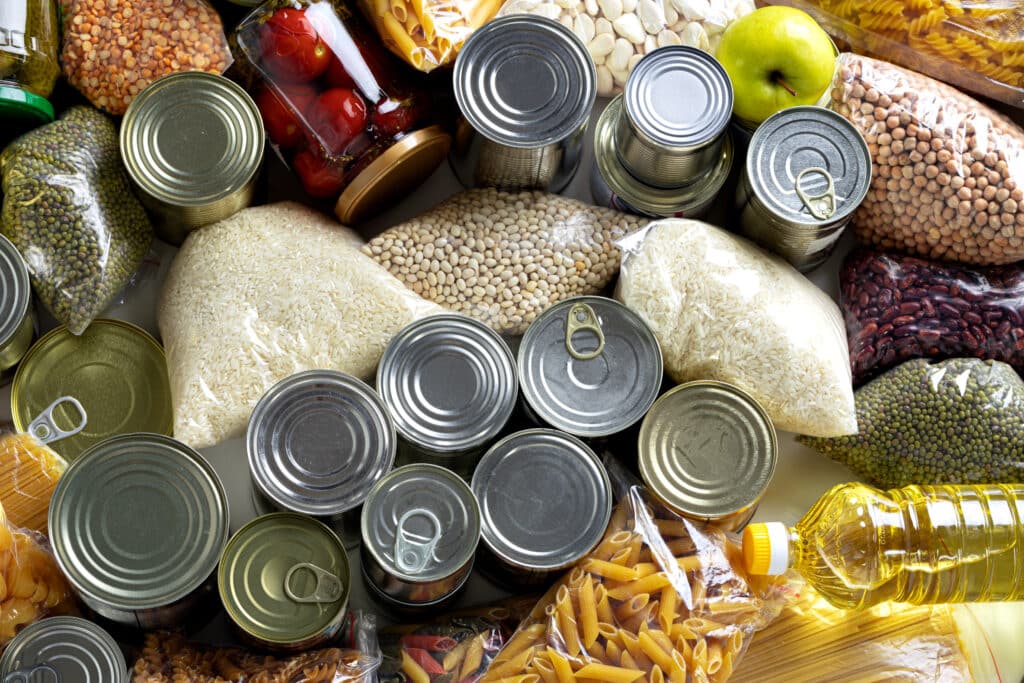
This is your front-line defense—the food you grab when it’s go-time. Whether it’s a wildfire, flood, or civil unrest, these foods are lightweight, shelf-stable, and ready to eat now. No cooking. No refrigeration. No nonsense.
What to stock:
- Protein bars – High calorie, no prep. Get a mix for variety.
- Trail mix – Sweet, salty, and full of energy. Bonus if it includes dried fruit.
- Canned chili, beans, soups – Choose options with pull-tab lids and high protein.
- Tuna or chicken pouches – Lightweight and shelf-stable for 2+ years.
- Instant oatmeal packets – Just add hot water (or cold if you’re desperate).
- Peanut butter – Calorie-dense and never disappoints.
- Electrolyte drink mix – Hydration matters when you’re sweating out survival.
Storage Tip:
Pack it all in a bug-out bag or emergency tote. Replace items every 6–12 months. Think portable pantry, not pantry hoarder.
🔹 Layer 2: 2–3 Week Pantry Supply (The Shelter-In-Place Lifesaver)
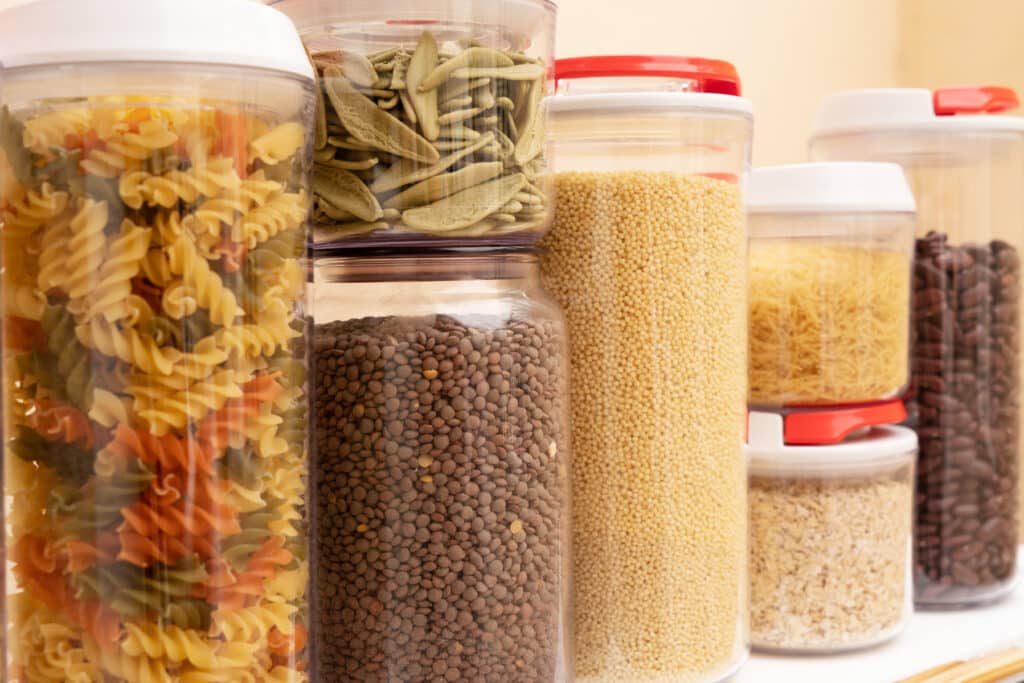
When staying put makes more sense than bugging out, this layer kicks in. It covers short disruptions—quarantines, storms, local shortages—with food that’s easy to cook, comforting, and part of your regular diet.
What to include:
- Dry staples: Rice, pasta, lentils, beans – cheap, filling, and versatile.
- Shelf-stable milk or powdered dairy – For coffee, cereal, and sanity.
- Canned vegetables, meats, and fruits – Look for low-sodium, multi-use items.
- Boxed meals: Mac & cheese, pancake mix, pasta sides – Comfort carbs with a long shelf life.
- Baking basics: Sugar, flour, baking soda, oil – For home-cooked survival magic.
- Instant coffee and tea – Because caffeine withdrawal in a crisis is a real enemy.
Rotation Rule:
Use the FIFO method (First In, First Out). Eat what you store, store what you eat. Label with sharpie. Rotate every 6–12 months like a kitchen ninja.
🔹 Layer 3: Long-Term Supply (The Deep Freeze of Your Dreams)

This is your ace-in-the-hole—designed to last years, not months. Ideal for true grid-down scenarios, long-term inflation, or if you just enjoy peace of mind knowing you could outlast half the neighborhood without ordering Uber Eats.
Essentials:
- Freeze-dried meals (25+ year shelf life): Backpacker’s Pantry, ReadyWise, Mountain House. Add boiling water and you’ve got lasagna in a blackout.
- White rice and dried beans: Vacuum-sealed in mylar bags with oxygen absorbers = decades of storage.
- Powdered eggs, milk, cheese: A little weird, very useful.
- Honey: Never expires. Nature’s original energy gel.
- Wheat berries, oats, flour: Store whole grains for max shelf life. Grind as needed.
Add-on MVPs:
- Bouillon cubes: Add flavor to bland basics.
- Salt: For preserving food and seasoning bland rations.
- Multivitamins: To cover nutritional gaps if your diet goes full rice-and-beans for a while.
Storage Smart Tips:
- Store in cool, dry, dark places like closets or under beds.
- Use airtight containers, mylar bags, and oxygen absorbers.
- Label everything. Track inventory in a spreadsheet or notebook.
Store It Right or Regret It Later
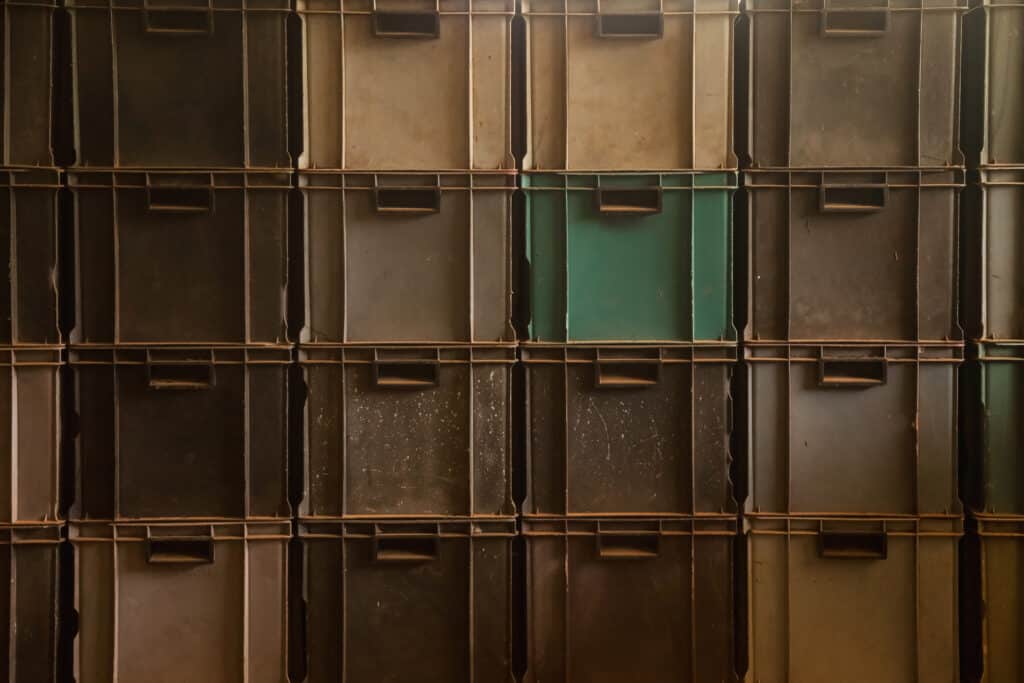
You spent good money on your food stockpile—don’t let it turn into a moldy science experiment or a mouse buffet. Proper storage isn’t optional. It’s the difference between eating well in a crisis and wondering if expired chili counts as a biohazard.
Here are the golden rules of food storage—and why they matter:
🔹 Cool, Dry, and Dark = The Prepper’s Holy Trinity
Heat speeds up spoilage. Moisture invites mold. Sunlight destroys nutrients.
Translation? Don’t store your beans next to the furnace or in front of a sunlit kitchen window. Find a cool (50–70°F), dry space—like a basement shelf, a closet, or under-bed bins if you’re short on space. And keep it dark—sunlight is great for Instagram photos, not for rice storage.
Smart Prepper Tip: Use a cheap thermometer/hygrometer combo to monitor temp and humidity in your storage area. If it’s too warm or damp, your food shelf life shrinks like your patience during a blackout.
🔹 Mylar Bags + Oxygen Absorbers = Shelf Life Magic
Want to turn a 2-year bag of rice into a 30-year insurance policy?
Seal it in 5-mil mylar bags with oxygen absorbers (OAs). The OAs suck out the oxygen that causes food degradation and spoilage. It’s like cryogenic freezing… but for beans.
Best Foods for Mylar/OA Treatment:
- White rice
- Dried beans
- Pasta
- Wheat berries
- Rolled oats
- Dehydrated veggies
Once sealed, store these bags in buckets or bins to protect them from rodents and punctures.
🔹 Sealed Bins Keep Out Critters, Moisture, and Murphy’s Law
Plastic totes or food-grade buckets are your second line of defense. Even if your mylar bags are perfect, all it takes is one curious mouse or leaky pipe to ruin everything. Use stackable, airtight bins with tight lids to keep your stash safe and organized.
Label each bin by category: “Rice & Beans,” “Breakfast Foods,” “Canned Meats,” “Grab-N-Go.” It’s like having your own personal grocery store—minus the judgmental stares from the checkout clerk.
🔹 Label EVERYTHING with Purchase and Expiration Dates
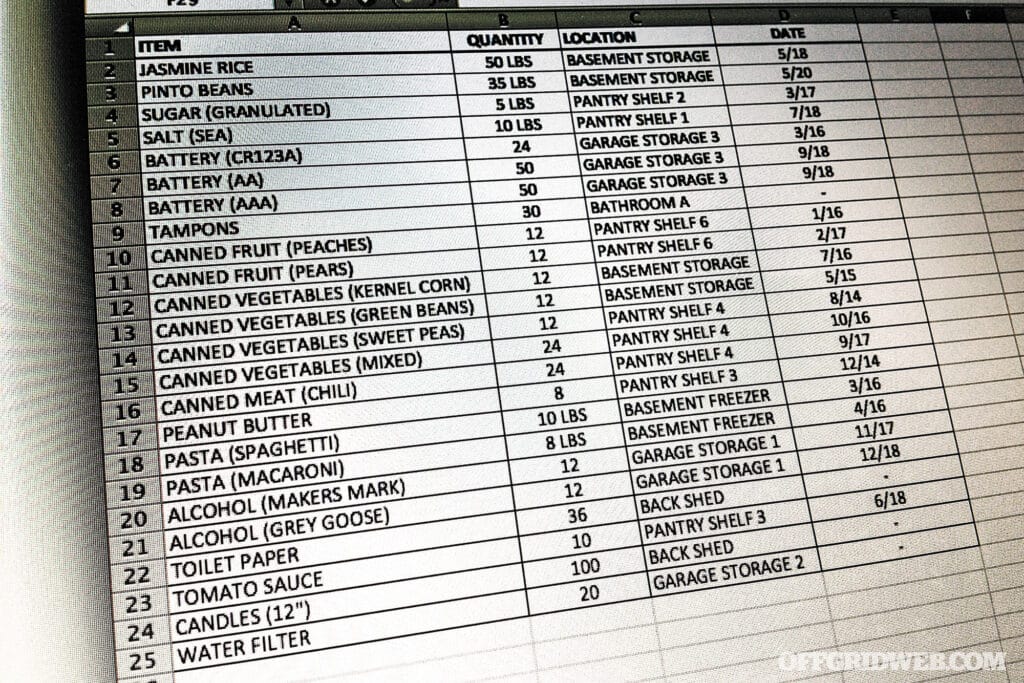
If you don’t label it, you’ll forget what it is—and when you bought it. Trust us. Six months from now, “Mystery Bag #3” won’t inspire culinary confidence.
- Use a Sharpie or label maker on all containers and mylar bags.
- Include purchase date and, if relevant, best-by date.
- Create a simple spreadsheet or inventory sheet to track what you have and when to rotate.
You’re not just storing food—you’re managing a small grocery warehouse. But with better lighting and zero Muzak.
Start Small: Budget Tips for Building a Stockpile
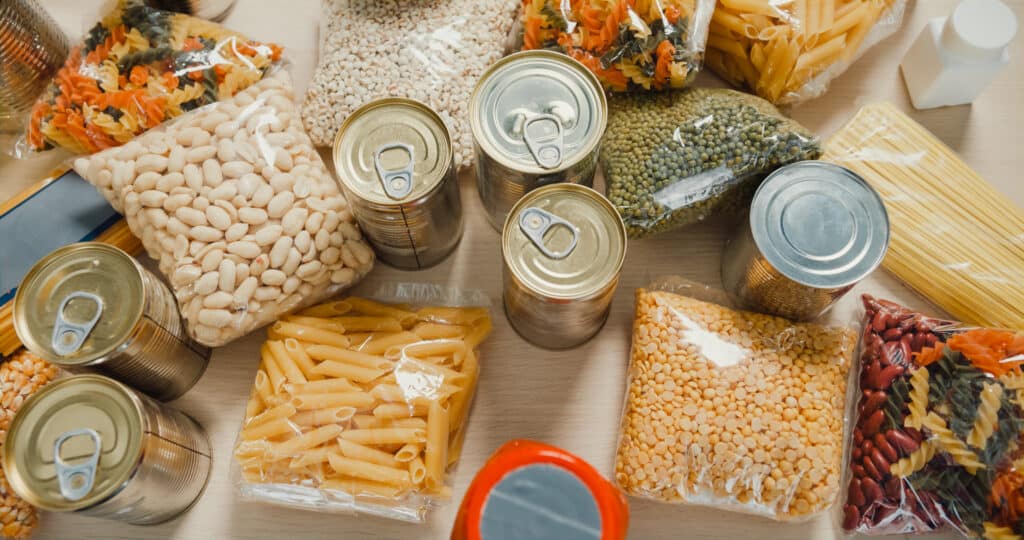
You don’t need to sell a kidney or live off lentils to start prepping. Building a food stockpile is like growing a beard—slow, steady, and a little itchy at first, but totally worth it in the end.
Here’s how to bulk up your pantry without thinning your wallet:
- Add $5–10 in bulk staples per trip: Grab a bag of rice, a few cans of soup, or a box of pasta each time you shop. It adds up faster than you think—and it doesn’t feel like a budget sucker.
- Warehouse clubs are your best friend: Costco, Sam’s Club, BJ’s—these places are prepper wonderlands. You can buy 25 lbs. of rice, 8 cans of chicken, and a year’s supply of peanut butter in one glorious run.
- Use Amazon’s Subscribe & Save for essentials: Save up to 15% on regular deliveries of canned goods, powdered milk, protein bars, and toilet paper. Bonus: you’ll never run out when it matters.
- Watch local sales flyers: Track store ads and markdowns. Learn the sales cycles for canned goods and pantry staples—stock up when prices dip.
- Don’t ignore dollar stores: They’re gold mines for canned veggies, pasta, and emergency snacks. Just check the expiration dates—and maybe skip the off-brand meat in a can.
Learn to Use It—Not Just Store It
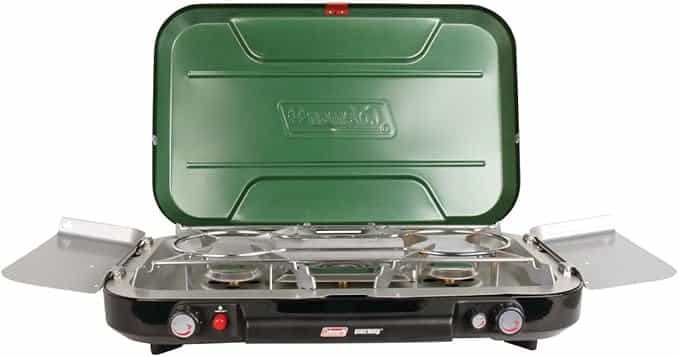
Food doesn’t magically save your life—it needs prep, know-how, and maybe a can opener that isn’t from the 1950s. Don’t be the guy who stockpiles 40 lbs. of beans and forgets he doesn’t know how to cook without a microwave.
Here are the skills every smart prepper should master:
- Cooking without power: Learn how to use solar ovens, propane camp stoves, rocket stoves, or even an upside-down Dutch oven on hot coals. Bonus points if you can make coffee off-grid.
- Make your own MREs (Meals Ready to Eat): Vacuum seal meals you actually like. Think rice + dehydrated chili + a protein bar + instant coffee. It’s survival with taste.
- Master water purification: Boil, filter, or purify with tablets or UV pens. Water is life—but only if it doesn’t give you gut gremlins.
- Food rotation: Know what you have, when it expires, and how to use it before it’s science-experiment-worthy. A spreadsheet or chalkboard list works great—and makes you feel like a prepper boss.
What NOT to Stockpile
Just because it’s shelf-stable doesn’t mean it deserves shelf space. Some items are better left on the clearance rack—or on the moon.
Avoid these common prepper fails:
- Ramen bricks: Yeah, they’re cheap. But they crumble, go stale, and won’t keep you full or fueled. Plus, your sodium levels will skyrocket before you ever eat enough to survive.
- #10 cans of food you’ll never eat: Unless you’ve got a family of 10 or a church basement, giant cans of freeze-dried broccoli are just future landfill. They spoil once opened, and you’ll never finish them alone.
- Weird canned stuff you wouldn’t touch sober: Pickled beets, mystery meat, creamed spinach—if you wouldn’t eat it on a good day, you won’t eat it in a disaster. Store what you like, or you’ll hate every meal.
Final Thoughts: It’s Not Paranoia—It’s a Plan
Final Thoughts: It’s Not Paranoia—It’s a Plan
Prepping isn’t about tinfoil hats or bunker bunk beds—it’s about taking responsibility. When the lights go out or the trucks stop rolling in, your food stash becomes freedom: the freedom to eat well, to stay calm, and to avoid raiding the vending machine at a gas station 20 miles away.
Start with what you have, grow it with purpose, and build a pantry that works for you—not just in emergencies, but every day. Smart prepping isn’t fear-based. It’s future-proofing with flavor.
Want to put your preparedness to the test? Try running your own 7-Day Bug-Out Challenge to see if your food stockpile holds up under real pressure. Start small. Stay consistent. And don’t forget to rotate your peanut butter.
Related Posts You’ll Love:
- Step-by-Step: Run a 7-Day Bug-Out Challenge
- 10 Rookie Camping Mistakes You Should Never Make
- Best Freeze-Dried Food Brands for Preppers (Ranked)
Heads-Up, Fellow Preppers:
Some links in this post are sponsored or affiliate links. If you click and buy, I may earn a small commission—enough to restock my peanut butter and maybe add one more can of chili to the stash. I only recommend gear I trust, use, and would hide in a bug-out bag.

